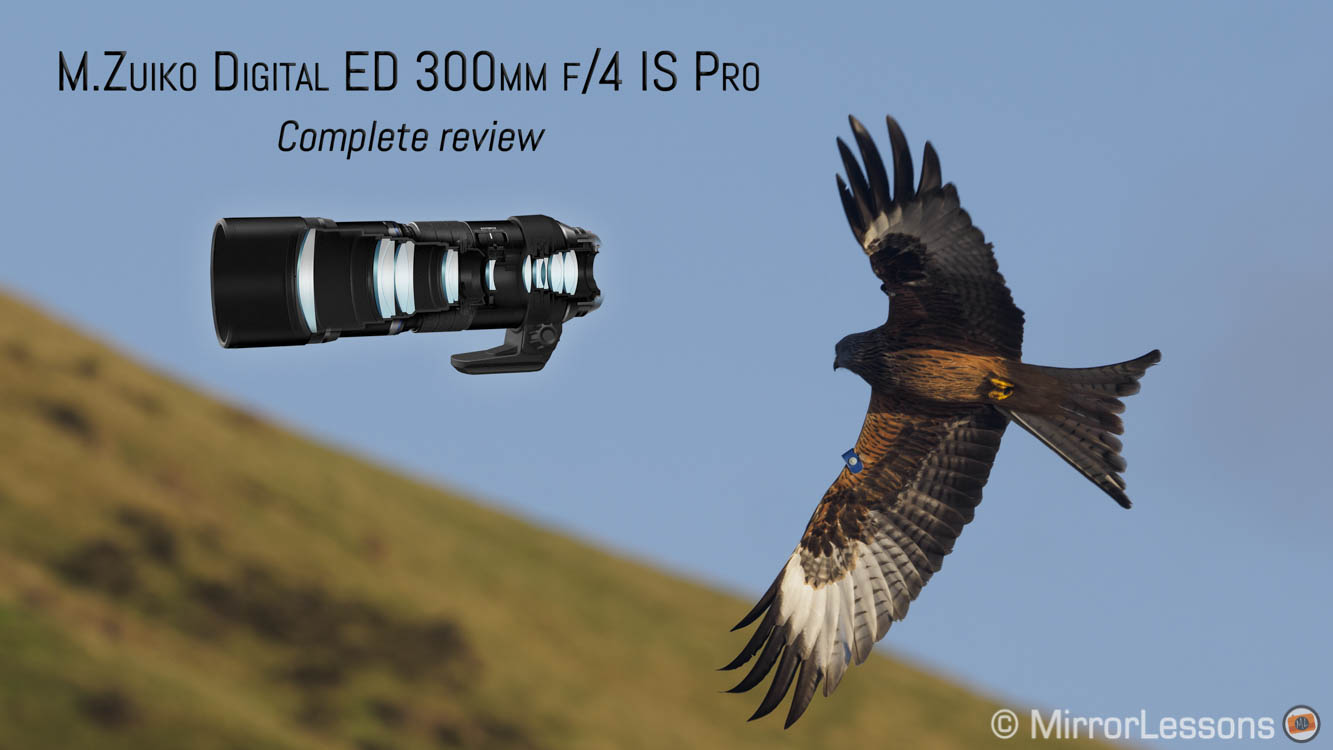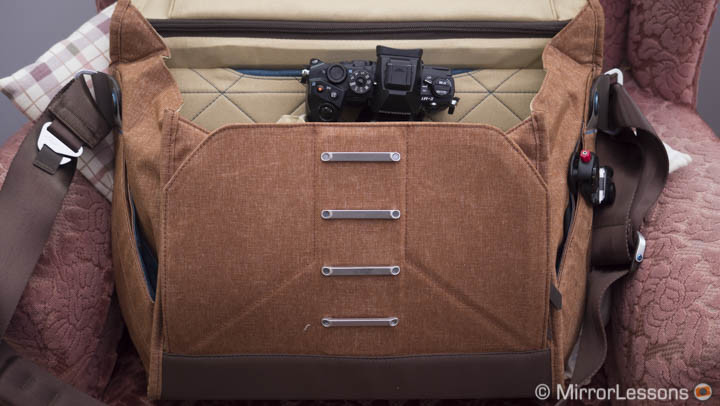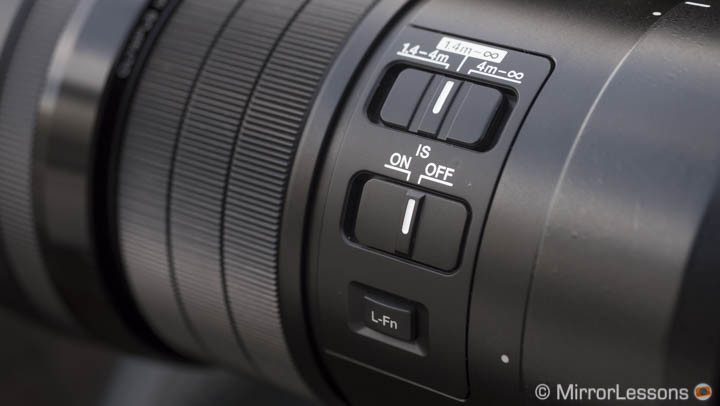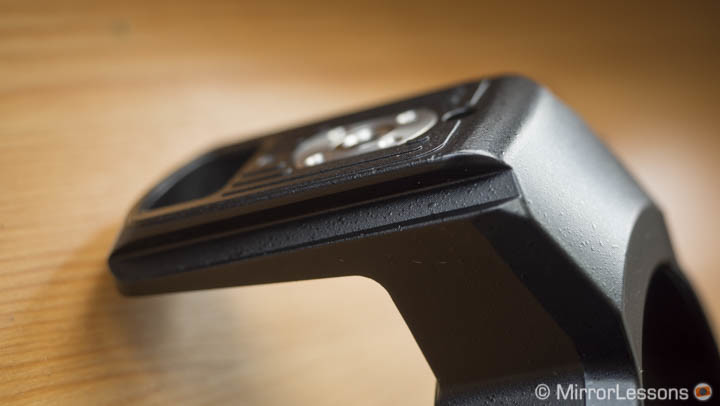The M.Zuiko 300mm f/4 is the fifth professional lens produced by Olympus for Micro Four Thirds. Its development was first announced in 2014 at Photokina but the release was delayed to add optical stabilisation – a wise move as it makes this telephoto lens an interesting choice for Panasonic customers as well.
I had the chance to use the 300mm f/4 during the Christmas holidays. Given the nature of this lens and its very long focal length (300mm is the equivalent of 600mm on a full-frame 24×36 sensor), I concentrated my efforts on bird photography. I am not an expert wildlife photographer, so reviewing this lens gave me the opportunity to become more familiar and comfortable with this genre. What’s more, winter is a good season because the trees are sparsely covered, making it easier to spot and photograph small birds in their natural habitat. Near the end of the testing period, I switched from birds to humans, taking the 300mm f/4 to a soccer game to test it in a sports environment.



M.Zuiko ED Digital 300mm f/4 IS Pro Main Specs
- Focal length: 300mm
- Focal length (equiv. 35mm): 600mm
- Maximum aperture: 4
- Minimum aperture: 22
- Number of aperture blades: 9 circular aperture diaphragm
- Angle of view: 4.1°
- Closest focusing distance: 1.4m
- Lens configuration: 17 elements / 10 groups
- Special elements: 3 Super ED, 2 HR and 1 E-HR elements
- Lens surface coating: N.d.
- Maximum image magnification: 0.48x (35 mm camera equivalent)
- Optical Image Stabiliser: Yes
- Dimensions: φ92.5 Ø, 227 mm
- Filter diamater: 77mm
- Weight: 1270g, 1475g with tripod collar
- Weather Sealed: Yes
[toc heading_levels=”3″]
Design and ease of use
The 300mm f/4 Pro shares the same excellent build quality as the other Pro lenses: it is weather-sealed with a strong metal finish.
It feels like the most robust lens Olympus has ever designed for the Micro Four Thirds system, which may be due to the fact that it is also the largest and heaviest to date.
By comparison, it is 6.7cm longer, 1.3cm larger and 510g heavier than the M.Zuiko 40-150mm f/2.8 Pro (see our review here) that was previously the largest M4/3 lens on the market.
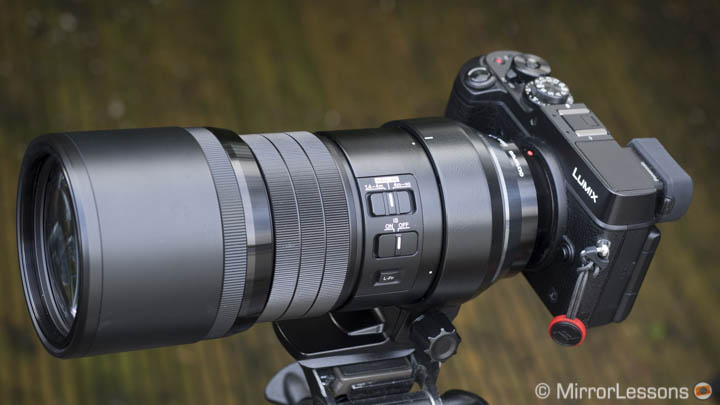
The 300mm f/4 is a little too large for some Micro Four Thirds cameras, especially bodies that lack a substantial grip like the E-M5 or E-M10 series. I tested it with the Olympus OM-D E-M1 and the Panasonic GX8 and with these two cameras, I found the overall ergonomics fine even without using the HDL-7 vertical battery grip on the E-M1. The camera/lens combo doesn’t feel too heavy when carried in a backpack but you definitely feel the weight more with a shoulder bag especially if you are carrying other equipment. To give you a size reference, the lens fits inside the Peak Design Everyday Messenger bag just fine when placed vertically with the camera attached. The same setup becomes too long for the Tenba Switch 10 or Cooper 13 Slim (the lens barely fits without the camera).
Concerning the ease of use, the 300mm features the same characteristics as the other Pro lenses. This includes an L-Fn button that can be customised and a focus ring that can be clutched to switch from auto to manual focus. The focus ring is nice and smooth to use when focusing manually despite being a “fly-by-wire” type. I used MF most of the time when recording video with the GX8. Bear in mind that it is not always easy to nail the focus precisely due to the extreme focal length, so some practice might be required. With the E-M1 or E-M5 II and the latest firmware updates (4.0 and 2.1), you can disable the function of the clutching mechanism (Custom Menu A. AF/MF) which is what I did after the first few days with the lens. I often ended up inadvertently clutching the focus ring while shooting, something that has happened with other Olympus Pro lenses as well.
Above the L-Fn button, you will find two switches. The first is the focus limiter with three different positions. It allows you to limit the focusing to a certain range of distances. Then there is the Internal Stabilisation switch to turn IS On or Off (more on this in the dedicated chapter).
Like the 40-150mm Pro, the lens has a removable tripod collar that can be rotated 360° and locked in any position you prefer. If you want to remove it, Olympus provides a plastic cover (the DR-79) that you can fit onto the lens. Personally I ended up keeping the tripod collar on all the time. I find it convenient to use with my Peak Design Slide strap to distribute the weight better. The tripod mount is compatible to Arca Swiss tripod heads meaning you can slide it in without the need to attach the plate.
[twentytwenty]


[/twentytwenty]
The lens hood is also clever: you simply slide it back over the lens barrel when you don’t need it. When you want to use it again, just slide it forward and rotate by 45° to lock it. It is the same mechanism as the one found on the M.Zuiko 60mm macro. The hood is made of solid plastic.
Through the lens: optical quality
As usual with this chapter, we start by talking about sharpness and rest assured, this is where the 300mm Pro doesn’t disappoint.
The optical performance is excellent from f/4 and you could end up using this aperture a lot for various reasons.
With sports or birds in flight for example, you need to use a fast shutter speed even if the light conditions aren’t great, so it becomes a matter of finding a balance between the aperture and ISO. Knowing that the fastest aperture is already sharp is definitely a comfort.




The performance increases slightly at f/5.6 and remains constant up to f/8. From f/11 there is the usual decrease in sharpness due to diffraction (a common thing with Micro Four Thirds lenses) but I must say the quality remains acceptable up to f/16. Of course it is unlikely that you will need to close your aperture that much unless you want to do some panning.




Click on the image to open the full res version.

Click on the image to open the full res version.

Click on the image to open the full res version.
The 300mm Pro has a minimum focus distance of 1.4 meters which is excellent for this type of lens. It allows you to get nice close-up shots of animals or other elements near you (as long as you manage to get close enough to them). Sharpness remains great at short distances even at f/4.
It’s nice to see that Olympus is keeping the short focus distance performance constant on every M.Zuiko Pro lens.
It is an aspect I really like about these lenses and that can be concretely useful, as it makes the entire Pro lens range more versatile. Remember that despite being a Micro Four Thirds lens and sensor, when photographing subjects at a close distance the depth of field can be narrow and you subject not completely in focus if you use a fast aperture.



Click on the image to open the full res version.
I haven’t found relevant traces of chromatic aberration or vignetting on either Olympus and Panasonic cameras. The only complaint I have about this lens concerns the bokeh. For isolating subjects at a long distance the results are fine. At shorter distances it can become quite nervous and unpleasant when you have out-of-focus elements close to the subject in both the foreground and background like branches of a tree. You don’t get natural and soft transitions but rather hard edges and double lines.

Click on the image to open the full res version.



Autofocus for birds
The 300mm f/4 provides a fast and silent internal focusing mechanism. In Single AF I didn’t encounter any particular problems with either the E-M1 and GX8. The only thing to highlight is that both cameras can struggle with busy compositions. In these situations, the lens elements may move back and forth in search of the highest point of contrast (and not always succeeding).

In Continuous Autofocus, the performance varies depending on the camera used. With Red Kites in flight, I got better results with the E-M1 because of its phase detection autofocus. However the results are not perfect and you will still end up with some images that are either slightly blurry or not 100% tack sharp.



Since firmware 3.0, the E-M1’s autofocus capabilities in continuous mode have been enhanced.
You can now shoot with focus priority up to 9fps in High mode. I used the Group target (9‑areas) mostly for birds in flight and switched to the smaller single AF point for static shots (birds in the trees). There is also a setting called C-AF Lock (Custom Menu A). You have four different options to tell the camera how fast it should track your subject. With birds it can be useful to set it to Normal to avoid sudden focus changes (for example if another bird appears in the frame between you and your subject). Also make sure to leave the Rls Priority to Off (Custom Menu C). Another useful setting is to set Short for the Release Lag-Time for the EVF (Custom Menu C) and High for the Frame Rate (Custom Menu D). Note that with the two latter settings, the battery life will drain more quickly.
I got a lower rate of success with the GX8 (around 50% vs 75% with the E-M1). The Panasonic struggled more due to its contrast detection system. I used a custom AF area with 9 points at the centre and the fastest continuous shooting mode with live view which is the M setting. Unfortunately with the faster rate (H) the live view is disabled and that makes it more difficult to track the birds. I kept the release priority to Focus here as well.

Click on the image to open the full res version.

For the starling murmuration, I used the 49 Wide area on the GX8 since there were so many birds filling the frame with this long lens. Starlings are really fast and following them is quite challenging but also very interesting. Here as well I got a mix of blurry, slightly blurry and sharp shots.


Autofocus for soccer
I attended a soccer game at the Welsh Premier League at the Park Avenue stadium in Aberystwyth. Here things became trickier. The lens was slightly too long for the soccer field I had the chance to visit. I was able to stay very close to the field and many times my focal length was too long to capture some action so I had to concentrate on close-ups.

When the players were more distant, I managed to capture interesting scenes. I am not an expert soccer photographer and it is quite difficult to follow the fast action with such a long lens.
The best set-up would probably be to use both the 40-150mm f/2.8 and the 300mm f/4.


Here I only used the E-M1 because I wanted to avoid switching between cameras all the time. I kept the same 9-group Area but this time I set the C-AF Lock to off. Things doesn’t always happen following a straight line or at a constant speed and the distance changes quickly. What’s more, your subject can often go in front of or behind the other players. So it is better that the AF be as reactive as possible for every eventuality.


Here overall the AF struggled more. The camera often focused on the background instead of the player and by the time it had rediscovered the subject, it was too late. Sometimes the camera would fail to lock and therefore wouldn’t initiate the burst of shots, causing me to miss the action. What’s more, in these cases, the camera would occasionally take a picture out of the blue, as if it had experienced a delayed reaction. This can be distracting when shooting this type of action.

In the second half of the game it started to become dark and I had to push the ISO up to 3200. The AF performance didn’t decrease and I could still focus at a very fast speed. However this is where I can bring up the aperture topic. If you need to cover this kind of game in the evening when there is nothing but artificial light, a f/2.8 aperture would allow you to keep your ISO below 3200. If this lens was a f/2.8 version, I think it would be perfect.


Internal Stabilisation
One of the most interesting specifications of this new 300mm f/4 Pro is the optical stabilisation. Actually it is a first for an Olympus Micro Four Thirds lens. Up until now Olympus only relied on sensor stabilisation and its 5-axis system has become the best you can find on the market. However, while excluding optical stabilisation from its lenses allowed the brand to keep the size smaller, it also limits their usefulness with Panasonic cameras that lack sensor stabilisation (all bodies except for the GX7 and GX8). Also, while the 5-axes are excellent, with such a large and long lens, it is better to have optical stabilisation as well. This is why implementing IS on the 300mm f/4 makes perfect sense. I even started to wonder why they didn’t do the same with the 40-150mm f/2.8 Pro.
Here again the performance will vary depending on which camera you use. Within the Olympus range, we have to separate the E-M1 and E-M5 mark II from the other OM-D and Pen cameras. When the lens is attached to the E-M1 or E-M5 mark II with their latest firmwares installed, both stabilisation systems (optical and sensor) will be used together to produce what Olympus calls Sync IS. In fact if you turn off the IS on the lens, the IBIS on the camera is de-activated as well. Once IS is enabled on the lens, you can choose the IBIS type on the camera. I found that leaving it to Auto was often the best option. Olympus claims 6 stops of compensation.
During my tests, I managed to get sharp results down to 0.4s which is quite impressive.

With other OM-D and Pen cameras, you can choose to prioritise the Lens IS (Custom Menu C) or use the sensor stabilisation instead. They won’t work together.
With Panasonic cameras, only the optical stabilisation will be effective. It is true that the GX8 has a similar system to the Olympus Sync IS called Dual IS. Unfortunately it only works with select Panasonic lenses so in this case, I could only benefit from the lens IS. That could seem like a limitation somehow but the truth is that the internal stabilisation of the 300mm is quite stunning. I managed to get sharp results down to 1/6s.

In general, keep in mind that the performance won’t always be constant and can be influenced by different things, not least how steady you are in a real-world shooting environment. I sometimes ended up with slightly blurry shots at 1/80s or 1/160s for example. Also remember that the GX8 suffers from shutter shock so it is better to use the electronic shutter between 1/60s and 1/320s. With the E-M1, I got slightly blurry shots at certain shutter speeds as well. I found the shutter shock less severe than the GX8 but it can happen. The best option is to use the first electronic curtain shutter (Anti-Shock 0) by selecting the single shot option with the rhombus symbol. Note that the Anti-Shock mode is not available with the fastest continuous shooting speed.


Video use
For wildlife videographers, this lens can be a great option because of its focal length and its excellent optical stabilisation. I recorded some 4K footage with the Panasonic GX8. Continuous AF is often unreliable because the camera is too slow in reacting and changing the focus properly. It works slightly better with long distant subjects. Note that while the IS works well overall, you can occasionally experience sudden shifts in movement.
I also tried a few shots with the E-M1 and my conclusions are similar concerning the AF. The stabilisation system works in the same way as with stills on the E-M1 and E-M5 II. It uses both sensor and optical stabilisation (Sync IS). The results are really effective with the E-M1 as well as far as video is concerned.
Below you can watch a video compilation with footage shot in 4k with the GX8 and the 300mm f/4 Pro. Most of my shots were taken in manual focus mode either hand-held or with the use of a Monopod to be more stable and comfortable.
Conclusion
For the conclusion, I saved the two aspects that I am sure will generate some discussion: the size/weight and the price. The latter can be dealt with quickly: the lens is expensive (almost €3000), perhaps a little too much much considering the f/4 aperture. Moving on, we can also ask ourselves:
Is the M.Zuiko 300mm f/4 Pro too big for a Micro Four Thirds (mirrorless) body?
We could do a comparison strictly based on the markings found on the barrel and lament the fact that the Olympus version is larger and heavier than the Nikkor or Canon 300mm f/4 while we would expect it to be the other way around. Or we could instead praise the fact that this Olympus 300mm gives us the same angle of view as a 600mm f/4 gives on a full-frame DSLR for 1/3rd of the weight, 1/2 the size and 1/5th of the price.

Putting aside all the possible comparisons between price, camera systems, sensor size and focal lengths (real and equivalent), I think it is also fair to remind ourselves that right now, there is nothing like the 300mm f/4 in the M4/3 system.
It is the first professional extreme telephoto prime lens available. It is clear that it is designed for professional and advanced photographers and for very specific genres.
Now I won’t lie to you: I do find this 300mm Pro a little too heavy and large for the Micro Four Thirds system. In fact it could be quite uncomfortable on a camera smaller than the E-M1, GX8 or GH4. On the other hand, I shot with it for 90 minutes straight at a soccer game and my arms were only slightly tired at the end. So in a way, the lens still provides the advantages I would expect from a smaller system. Perhaps the size could be more easily accepted if it were a f/2.8 lens. But that also makes me think that a f/2.8 version would probably be too large and too expensive for what the Micro Four Thirds system can handle right now.
On a final note, the 300mm Pro becomes the second lens to be compatible with the Olympus MC-14 1.4X Teleconverter. You lose one stop of light (f/5.6 becomes the fastest) but you gain 120mm (240mm full frame equivalent).
You can check out our sample image gallery taken with the 300mm and the MC-14 here.
The 300mm f/4 IS Pro will be available in March 2016.
 What I like about the Olympus 300mm f/4 Pro:
What I like about the Olympus 300mm f/4 Pro:
- Solid build quality and weather resistant
- The lens hood can be slid back over the barrel
- Excellent sharpness from f/4 already
- Focuses as close as 1.4m
- Fast internal focusing
- Excellent internal stabilisation
- Compatible with the MC-14 1.4x Teleconverter
 What I don’t like about the Olympus 300mm f/4 Pro:
What I don’t like about the Olympus 300mm f/4 Pro:
- The largest and heaviest Micro Four Thirds lens on the market
- Expensive
- Bokeh can be unpleasant
You can check out additional full res image samples on our Mirrorless Curation blog here.
